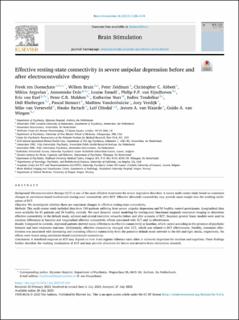| dc.contributor.author | ten Doesschate, Freek | |
| dc.contributor.author | Bruin, Willem | |
| dc.contributor.author | Zeidman, Peter | |
| dc.contributor.author | Abbott, Christopher C. | |
| dc.contributor.author | Argyelan, Miklos | |
| dc.contributor.author | Dols, Annemieke | |
| dc.contributor.author | Emsell, Louise | |
| dc.contributor.author | van Eijndhoven, Philip F.P. | |
| dc.contributor.author | van Exel, Eric | |
| dc.contributor.author | Mulders, Peter C.R. | |
| dc.contributor.author | Narr, Katherine | |
| dc.contributor.author | Tendolkar, Indira | |
| dc.contributor.author | Rhebergen, Didi | |
| dc.contributor.author | Sienaert, Pascal | |
| dc.contributor.author | Vandenbulcke, Mathieu | |
| dc.contributor.author | Verdijk, Joey | |
| dc.contributor.author | van Verseveld, Mike | |
| dc.contributor.author | Bartsch, Hauke | |
| dc.contributor.author | Oltedal, Leif | |
| dc.contributor.author | van Waarde, Jeroen A. | |
| dc.contributor.author | van Wingen, Guido A. | |
| dc.date.accessioned | 2023-10-09T08:00:35Z | |
| dc.date.available | 2023-10-09T08:00:35Z | |
| dc.date.created | 2023-09-29T14:08:46Z | |
| dc.date.issued | 2023 | |
| dc.identifier.issn | 1935-861X | |
| dc.identifier.uri | https://hdl.handle.net/11250/3095151 | |
| dc.description.abstract | Background
Electroconvulsive therapy (ECT) is one of the most effective treatments for severe depressive disorders. A recent multi-center study found no consistent changes in correlation-based (undirected) resting-state connectivity after ECT. Effective (directed) connectivity may provide more insight into the working mechanism of ECT.
Objective
We investigated whether there are consistent changes in effective resting-state connectivity.
Methods
This multi-center study included data from 189 patients suffering from severe unipolar depression and 59 healthy control participants. Longitudinal data were available for 81 patients and 24 healthy controls. We used dynamic causal modeling for resting-state functional magnetic resonance imaging to determine effective connectivity in the default mode, salience and central executive networks before and after a course of ECT. Bayesian general linear models were used to examine differences in baseline and longitudinal effective connectivity effects associated with ECT and its effectiveness.
Results
Compared to controls, depressed patients showed many differences in effective connectivity at baseline, which varied according to the presence of psychotic features and later treatment outcome. Additionally, effective connectivity changed after ECT, which was related to ECT effectiveness. Notably, treatment effectiveness was associated with decreasing and increasing effective connectivity from the posterior default mode network to the left and right insula, respectively. No effects were found using correlation-based (undirected) connectivity.
Conclusions
A beneficial response to ECT may depend on how brain regions influence each other in networks important for emotion and cognition. These findings further elucidate the working mechanisms of ECT and may provide directions for future non-invasive brain stimulation research. | en_US |
| dc.language.iso | eng | en_US |
| dc.publisher | Elsevier | en_US |
| dc.rights | Navngivelse 4.0 Internasjonal | * |
| dc.rights.uri | http://creativecommons.org/licenses/by/4.0/deed.no | * |
| dc.title | Effective resting-state connectivity in severe unipolar depression before and after electroconvulsive therapy | en_US |
| dc.type | Journal article | en_US |
| dc.type | Peer reviewed | en_US |
| dc.description.version | publishedVersion | en_US |
| dc.rights.holder | Copyright 2023 The Author(s) | en_US |
| cristin.ispublished | true | |
| cristin.fulltext | original | |
| cristin.qualitycode | 1 | |
| dc.identifier.doi | 10.1016/j.brs.2023.07.054 | |
| dc.identifier.cristin | 2180340 | |
| dc.source.journal | Brain Stimulation | en_US |
| dc.source.pagenumber | 1128-1134 | en_US |
| dc.identifier.citation | Brain Stimulation. 2023, 16 (4), 1128-1134. | en_US |
| dc.source.volume | 16 | en_US |
| dc.source.issue | 4 | en_US |

